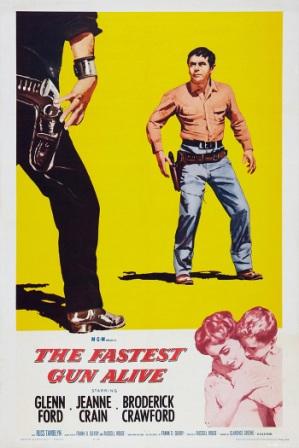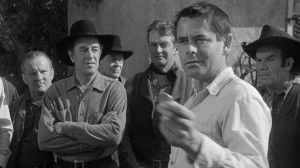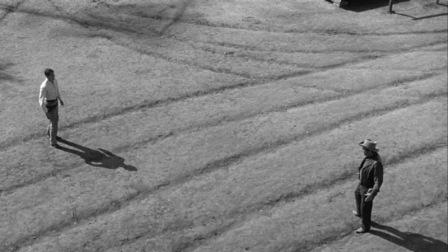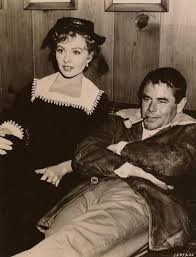 “You couldn’t see me draw! How can you say anyone’s faster?” — Vinnie Harold
“You couldn’t see me draw! How can you say anyone’s faster?” — Vinnie Harold
Any numbers of men fast with the gun have tried to live down their notoriety by retiring or hiding away in some isolated small town. Most famously, perhaps, Gregory Peck in The Gunfighter (1950), comes home to reunite with his secret wife and young son and ends up shot in the back by a young kid out to make a name for himself.
With a somewhat crazy plot, in A Gunfight (1971) two aging gunslingers, Kirk Douglas and Johnny Cash, decide to make money by staging a real gunfight to the death, winner take all. But the two become friends, and when one kills the other, he regrets it. Interestingly, the film has an epilogue explaining what would have happened had the other man won.
In his last film, John Wayne in The Shootist (1976) seeks a small town to face in peace his terminal illness, but, in learning that death will be horribly painful, decides to end it all in a last blaze of gunfire with some archenemies.
Though technically not a Western, in Friendly Persuasion (1952), Gary Cooper, a pacifist Quaker, tries to avoid violence during the American Civil War, but ends up fighting for his family, home and land.
Much like Cooper in Friendly Persuasion, James Stewart, a lawyer, has no past to live down, but takes marksmanship lessons out of rage. Quite by accident, and of someone else’s doing, he becomes famous—elected to Congress—because he supposedly shot an outlaw in The Man Who Shot Liberty Valance (1962).
 In The Fastest Gun Alive, George Kelby, Jr. (Glenn Ford) tries to escape, not his past but that of his father’s, a famous lawman. He and wife Dora (Jeanne Crain) have moved to the small town of Cross Creek where, now as George Temple, he becomes an easygoing storekeeper.
In The Fastest Gun Alive, George Kelby, Jr. (Glenn Ford) tries to escape, not his past but that of his father’s, a famous lawman. He and wife Dora (Jeanne Crain) have moved to the small town of Cross Creek where, now as George Temple, he becomes an easygoing storekeeper.
It’s not long, of course, before his identity is discovered, unfortunately through his own fallible ego. The outlaw Vinnie Harold (Broderick Crawford) makes a name for himself by shooting down the reputed “fastest gun in the west.” Vinnie is the talk of the town, and when George is mocked by comparison for his simple ways, he tells Dora that “they have to know who I am.”
 He retrieves his hidden gun, having told his wife he had thrown it into a river years ago. To prove his skill, with Dora looking on in distress that their quiet life is threatened once again, George has two men toss a silver dollar in the air and shoots holes in each before they hit the ground. As if this is not enough of a feat (probably impossible in reality), at twenty feet he smashes a full glass of beer seconds after another man (Allyn Joslyn) drops it—the keen viewer will notice that Ford draws a split second before the glass is released.
He retrieves his hidden gun, having told his wife he had thrown it into a river years ago. To prove his skill, with Dora looking on in distress that their quiet life is threatened once again, George has two men toss a silver dollar in the air and shoots holes in each before they hit the ground. As if this is not enough of a feat (probably impossible in reality), at twenty feet he smashes a full glass of beer seconds after another man (Allyn Joslyn) drops it—the keen viewer will notice that Ford draws a split second before the glass is released.
About this time, in a meeting in church that recalls High Noon (1952), the congregation has taken an oath to keep George’s secret. To no avail. Vinnie has heard of George’s expertise and, arriving with his bank-robbing partners, Swope and Dink (John Dehner and Noah Beery, Jr.), he threatens to burn down the town unless George faces him.
 George has to explain to everyone that he has never been in a gunfight, that it’s merely an acquired skill with a gun. The gun was his father’s and he has no desire to engage in a gunfight.
George has to explain to everyone that he has never been in a gunfight, that it’s merely an acquired skill with a gun. The gun was his father’s and he has no desire to engage in a gunfight.
Swope and Dink abandon Vinnie, leaving without their share of the money grabbed in a bank robbery. Swope at first is tempted to draw on Vinnie for his share of the money, but backs down, showing to the film’s credit a restraint; the customary practice is to simply have another gratuitous gunfight.
 George is forced to strap on his gun when Lou Glover (Leif Erickson) volunteers to take his place against Vinnie. George and Vinnie face off in the street, draw their guns and fire. Immediate fade out.
George is forced to strap on his gun when Lou Glover (Leif Erickson) volunteers to take his place against Vinnie. George and Vinnie face off in the street, draw their guns and fire. Immediate fade out.
Next scene, the town’s citizens are attending a funeral. They tell a passing posse which is pursuing Swope and Dink that George and Vinnie shot each other dead. Later, it’s revealed that George’s coffin was filled with stones and contained his father’s gun. His reputation as “the fastest gun alive” thus buried, George and Dora have another chance of living a normal life in Cross Creek.
A typical Western on the surface, it is, in many ways, quite atypical. As suggested earlier, the violence is restrained and an earnest effort concentrates on the adroit cinematography of the thirteen-time Oscar nominated George Folsey and on the acting.
 Glenn Ford, always a dependable actor in everything he does and a good fit in any number of genres, is here earnest and, in the frequent displays of anger, quite convincing. Jeanne Crain has little to do except be the cliché stalwart wife.
Glenn Ford, always a dependable actor in everything he does and a good fit in any number of genres, is here earnest and, in the frequent displays of anger, quite convincing. Jeanne Crain has little to do except be the cliché stalwart wife.
The array of supporting players in The Fastest Gun Alive represents both familiar faces from the 1930s and ’40s and their upcoming replacements who would become almost as familiar in the ’50s and ’60s. Beyond Erickson, Dehner and others already listed, there is Russ Tamblyn, famous for his dancing in Seven Brides for Seven Brothers (1954) and West Side Story (1961).
J.M. Kerrigan, Rhys Williams and Virginia Gregg have roots in earlier decades, while John Doucette, inevitably a bad guy in a forty-year career, made over 280 films. There is also the seemingly always angry Ray Bennett, maybe best remembered with a facial scar. Paul Birch, Chubby Johnson, William “Bill” Phillips and Walter Coy, if not familiar by name, are certainly recognizable on screen.
[embedyt] https://www.youtube.com/watch?v=XZowj5-IYxI[/embedyt]